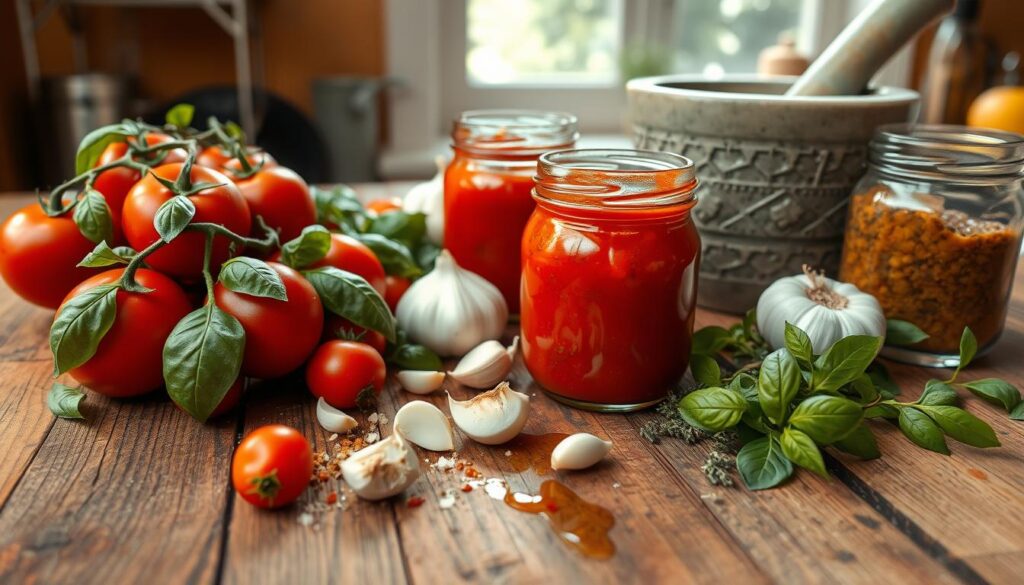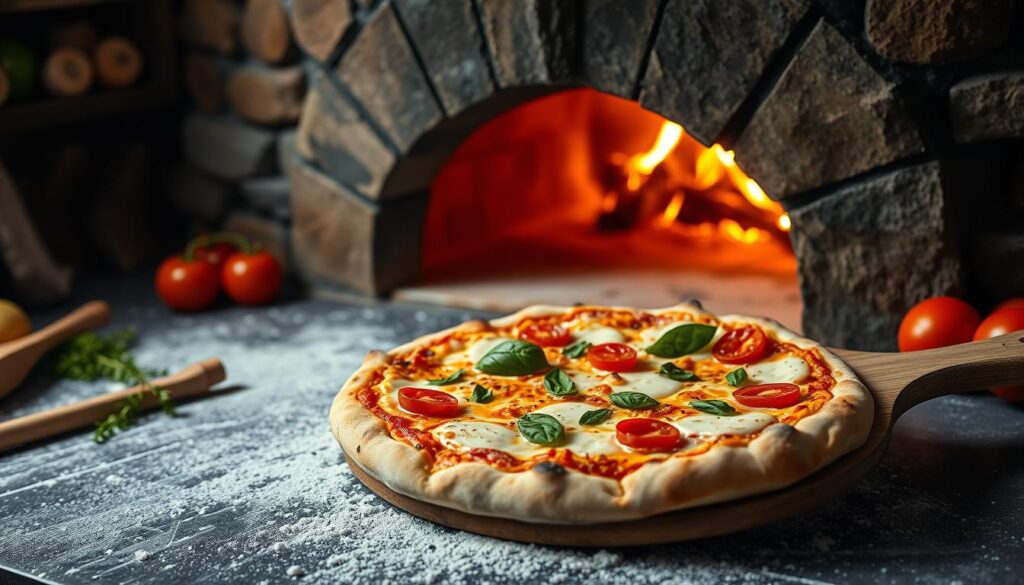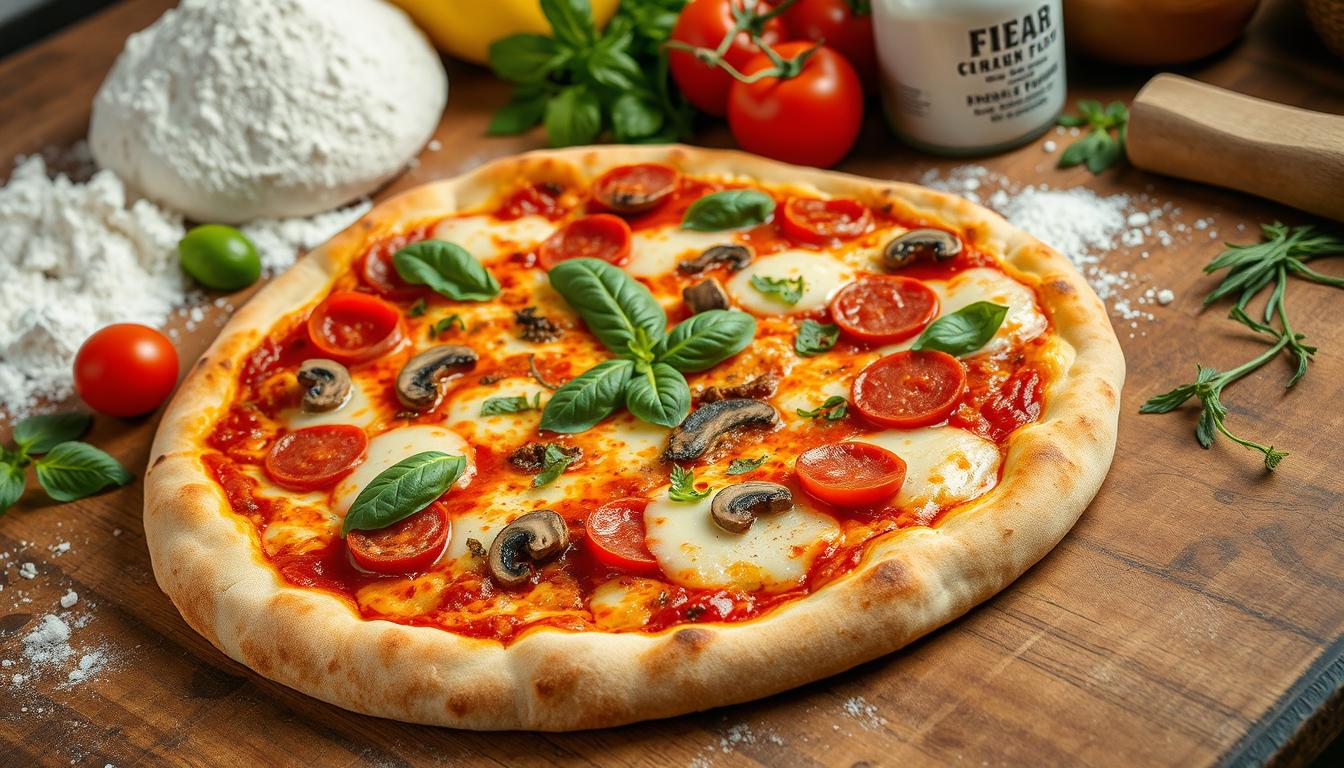Imagine biting into a slice of pizza with a perfectly crisp yet chewy crust. The melted cheese stretches with every bite. And the flavors from fresh herbs and ripe tomatoes burst in your mouth. This is what you can make in your kitchen with the right ingredients and techniques.
At the heart of a great pizza is the perfect mix of freshness, texture, and flavor. By learning how to make pizza, you can create pies that are as good as those from top pizzerias. This guide will show you how to make the ultimate pizza experience, whether you’re a pro or just starting out.
Key Takeaways
- Discover the art of crafting authentic, homemade pizza with fresh, high-quality ingredients
- Learn the fundamentals of pizza dough preparation and the importance of temperature control
- Explore the best techniques for achieving a perfectly crisp and chewy pizza crust
- Uncover the secrets to creating delectable, flavorful pizza sauces from scratch
- Discover the most popular and innovative pizza topping combinations
The Art of Creating Authentic Pizza at Home
Making authentic pizza at home is a fun journey. It lets you learn about the basics of pizza dough and the right tools and temperature. This guide will help you make perfect pizza in your kitchen.
Understanding Pizza Dough Fundamentals
The heart of any good pizza is the dough. Learn about the ingredients, mixing, and proofing to make tasty dough. Try different flours, yeast, and water levels to find your favorite.
Essential Equipment for Pizza Making
You don’t need a fancy oven to make great pizza. But, the right tools can help a lot. Get a strong pizza peel, a baking stone or steel, and a good oven that can get hot.
The Role of Temperature in Perfect Pizza
Temperature is key for the perfect pizza. Make sure your oven and stone are hot enough. This affects the crust, toppings, and pizza’s texture. Try different ways to cook, like stone oven or cast-iron, to see what works best for you.
Learning about pizza dough, tools, and temperature will help you make amazing pizza at home. You’ll impress everyone with your pizza skills!
| Essential Pizza-Making Equipment | Why It Matters |
|---|---|
| Pizza Peel | Allows you to easily transfer the pizza from the counter to the oven and back. |
| Baking Stone or Steel | Mimics the high-heat environment of a professional pizza oven, helping to achieve a crisp crust. |
| Oven Thermometer | Ensures your oven reaches and maintains the ideal temperature for baking pizza. |
Selecting Premium Ingredients for Your Pizza
Making the perfect pizza at home begins with the best ingredients. From cheese to tomatoes and herbs, each part is key. Let’s look at the important choices for a great homemade pizza.
Fresh vs. Aged Mozzarella
The choice between fresh and aged mozzarella is big. Fresh mozzarella is soft and creamy, adding a milky taste. Aged mozzarella, on the other hand, has a deeper flavor and a chewier texture.
Choosing the Right Tomatoes
Choosing the right tomatoes is also key. Go for high-quality, ripe tomatoes full of flavor. San Marzano tomatoes are sweet and low in acidity. You can also try heirloom tomatoes for their unique tastes and looks.
Herbs and Seasonings That Make a Difference
- Fresh basil leaves: They add a fragrant, herbal flavor to your pizza.
- Oregano: Dried oregano brings a warm, earthy taste.
- Garlic: Minced or roasted garlic boosts the aroma and taste.
- Red pepper flakes: They add a nice heat to your pizza.
By picking the best pizza ingredients, like fresh mozzarella, aged mozzarella, tomato selection, and pizza herbs, you can make a great homemade pizza. It will taste like a traditional Italian pizzeria.
Mastering the Perfect Pizza Dough
Making the perfect pizza dough is key to a great homemade pizza. By following simple steps and mastering certain techniques, you can create a dough that’s both tasty and has the right texture.
The pizza dough recipe starts with flour, yeast, water, and a bit of salt. The kneading and proofing steps are where the magic happens. Kneading techniques are important for building the dough’s chewy yet light texture.
- Start by mixing the dry ingredients until they’re well combined.
- Slowly add the water, kneading the dough until it’s smooth and elastic.
- Cover the dough and let it proof for at least 1 hour, or until it doubles in size.
Getting the right dough consistency is crucial. The dough should be slightly tacky but not too sticky. It should stretch easily without tearing. Proper kneading techniques and proofing time will help you achieve this.
“The secret to a perfect pizza dough lies in the details – from the right ratio of ingredients to the careful handling and proofing process.”
With these tips, you’re on your way to making great homemade pizza dough. Don’t be afraid to try different things and adjust the recipe until it’s just right for you.
Secrets of Traditional Pizza Sauce
Making the perfect pizza sauce is key to a great homemade pizza. You can start with a classic marinara or try creamy white sauces and unique specialty recipes. Learning to make pizza sauce can really improve your cooking skills.
Classic Marinara Base
The marinara pizza sauce is simple yet full of flavor. It’s made with ripe tomatoes, garlic, olive oil, and herbs. You can adjust it to fit your taste, making it perfect for your favorite toppings.
White Sauce Variations
If you want something different, try a white pizza sauce. It’s creamy and rich, made with cheese, cream, and spices. It’s a great base for your pizza, adding a new twist to your creations.
Specialty Sauce Recipes
Want to take your pizza to the next level? Try specialty pizza sauces for unique flavors. From pesto to barbecue, there are endless options to make your pizza stand out.
| Sauce Type | Key Ingredients | Flavor Profile |
|---|---|---|
| Marinara | Tomatoes, garlic, olive oil, herbs | Classic, savory, and tangy |
| White Sauce | Cheese, cream, seasonings | Creamy, rich, and indulgent |
| Specialty Sauces | Pesto, barbecue, alfredo, etc. | Unique, flavorful, and versatile |

“The secret to a great pizza lies in the sauce – it’s the canvas upon which all the other flavors are built.”
Top Pizza Toppings Combinations
The world of pizza toppings is full of flavors and textures. From classic favorites to gourmet creations, there’s endless possibility. We’ll look at some top topping combinations to make your homemade pizza amazing.
The classic pepperoni and mushroom pairing is a favorite. Pepperoni’s savory taste goes well with mushrooms’ earthy flavor. This mix of tastes and textures is perfect.
- Try sausage, bell peppers, and onions for a twist. Bell peppers’ sweetness and onions’ pungency contrast well with sausage’s robust flavor.
- Gourmet lovers will enjoy prosciutto, arugula, and shaved Parmesan. The salty prosciutto, peppery arugula, and nutty Parmesan make for a special pizza.
- Vegetarians will love roasted vegetables, feta, and fresh basil. Roasted zucchini, eggplant, and bell peppers with tangy feta and fragrant basil is satisfying and flavorful.
With pizza toppings, you can try endless combinations. Experimenting with different topping combinations lets you create gourmet pizza masterpieces at home.
“The secret to the perfect pizza lies in the harmony of its toppings.” – Julia Mariani, Renowned Pizza Chef
Cooking Methods for Restaurant-Quality Pizza
Making perfect pizza at home can seem hard. But, with the right cooking methods, you can get flavors and textures like a pro’s. Let’s look at three great ways to improve your homemade pizza.
Stone Oven Techniques
Getting the heat and even cooking of a stone oven at home changes the game. A pizza stone’s surface absorbs moisture, making the crust crisp and charred. To get this at home, preheat your oven with the stone for at least an hour. Then, slide your pizza onto the hot stone.
Cast Iron Method
A cast iron pizza can match the best stone oven pizza. Use a well-seasoned cast iron skillet. Preheat it hot, then add your dough and toppings quickly. The skillet makes a crust that’s golden and soft inside.
Grilling Your Pizza
Grilling pizza adds a special flavor. Start by grilling the dough on the grates, flipping it to char both sides. Then, add toppings and grill again to melt the cheese. This makes a smoky, charred pizza with a crisp crust.
Choose from stone oven, cast iron, or grilling for your pizza. These methods will make your pizza taste like it’s from a restaurant, all in your kitchen.

Common Pizza Making Mistakes to Avoid
Making the perfect homemade pizza is an art. Even experienced chefs can make mistakes. Issues like dough troubles, temperature control, and topping distribution can ruin your pizza. Don’t worry, we’ll show you how to avoid these mistakes and make a perfect pie.
Dough Problems and Solutions
The dough is key in pizza-making. Problems like sticky, tough, or flat dough can happen. To fix this, use a good dough recipe and technique. Knead well, proof at the right temperature, and use quality flour.
Temperature Control Issues
Temperature is crucial for a great pizza crust and toppings. Baking at the wrong pizza temperature can make your pizza soggy or burnt. Preheat your oven to 450-500°F and use a pizza stone or steel for even heat.
Topping Distribution Tips
Uneven topping distribution can mess up your pizza. Too many toppings make it soggy, while too few make it bare. Find the right balance by layering toppings evenly.
By avoiding these pizza-making mistakes, you’ll make a pizza that wows everyone. Happy baking!
Regional Pizza Styles Around the World
Pizza is loved by people all over the world. It has grown into many different styles, each with its own special touch. From Italy’s thin-crust Neapolitan pizza to Chicago’s deep-dish, the variety shows how versatile pizza can be.
In Naples, the Margherita pizza is a classic. It’s made with fresh mozzarella, basil, and San Marzano tomatoes. In New York City, the thin-crust slice is famous. It’s foldable and has a tangy tomato sauce.
The Greek-style pizza has a crispy crust and toppings like feta, olives, and oregano. California-style pizza is all about creativity, with toppings like grilled veggies and unique flavors. Meanwhile, wood-fired Neapolitan-style pizza focuses on quality ingredients and dough-making skills.

Leave a Reply
You must be logged in to post a comment.